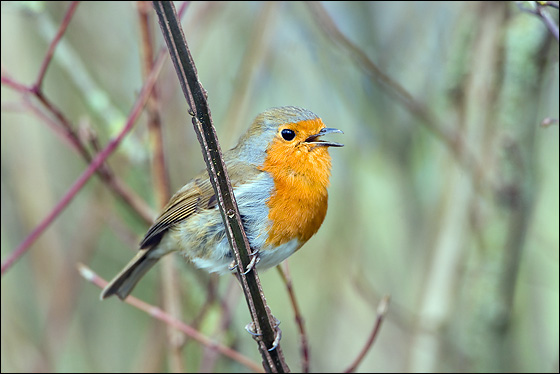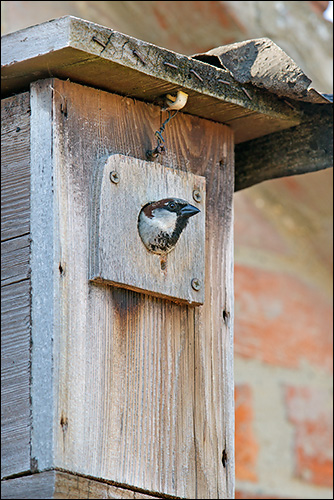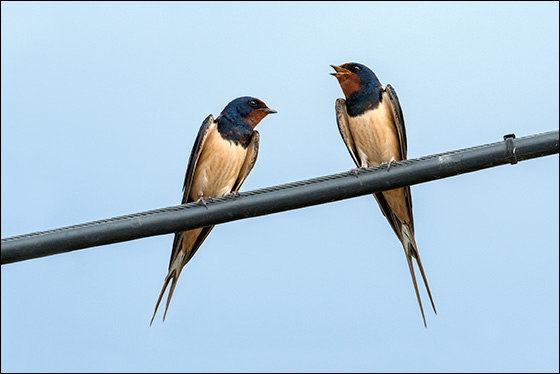This is an extract from my book “The Secret Lives of Garden Birds”. It’s the introduction to April. The whole book is available from the usual retailers.
APRIL is a month with a loud soundtrack. No male bird with pretensions towards reproduction can keep its mouth shut at this time of year. The atmosphere is always heavy with song, ready to drench any listener who steps outside.

Robin (Dave Kjaer)
Solos and Duets
By April, any male with a decent song should have firmly secured his territorial borders. His neighbours know his tune well and keep a respectful distance, leaving the singer and his mate to live in relative peace within their hard-won patch of ground. But it’s an uneasy truce, and any break now in the male’s vocal output would be disastrous. It would be the equivalent of cutting short an advertising campaign in the human world – suddenly your name would slip from the public’s mind and your competitors would win out. In the same way, an avian singing slouch would soon lose territory, mate and opportunity. He cannot afford to fall silent.
That’s why now, and right up until June or July, many species keep on singing their solos. It takes considerable effort, and in some birds such as Song Thrushes, Nuthatches and Chaffinches, it probably precludes males from taking part in such activities as nest-building and incubating young. The singing male and hard-pressed female would appear to divide their tasks unequally, yet the territorial song is the licence for everything.

House Sparrow (Passer domesticus) male in nest box (Dave Kjaer)
A Place to Nest
Somewhere safe behind their vocally defined borders, many a pair of birds will begin at about this time of year to construct a tangible structure: the nest. All over the garden, from mud in the flowerbeds to grass clippings on the compost-heap, from old leaves under shrubs to moss growing on the side of a stone, building materials are being moved by dozens of bills.
It is tempting to view nests as “homes”, where birds live, come back from work and put their feet up. But in reality, a nest is a dangerous place, a potential trap. Once linked to one, birds that are normally highly mobile, evasive and unpredictable become much more calculable and vulnerable to predators. But of course, a nest is essential. If it does nothing else, it keeps all the eggs together, so that parent birds know where they are, and where they should focus their attentions. When a bird is incubating, the nest also helps to keep the eggs under the “brood patch,” an area on a bird’s belly from which feathers are shed so that the shells make direct contact with the parent bird’s skin. So in a way, nest and bird work in some sort of harmony.
Being Constructive
For most birds, the most agonising part of the nest-building process appears to be deciding on the right site. The next stage, constructing the nest itself, can have the feel of an afterthought once the hard choices have been made. And many structures seem to reflect this. Pigeon nests can have such a slapdash foundation that it is possible to see the eggs from below. House Sparrows simply stuff material in a hole, giving their nests the unmistakable signature of a cowboy builder. Even the Robin, which builds quite a respectable model of leaves, grass, moss and finer materials, only takes about four days from start to finish, working just a few hours each day, mostly in the morning.

Barn Swallow (Dave Kjaer)
Guard Duty
A practice that [takes place as the female prepares to lay] is guard duty. This is where a male attends a feeding female and watches out for danger on her behalf. This is a surprisingly efficient way to ensure she obtains the extra food she needs, since her foraging will be much less disturbed and much more nourishing than usual. In the course of normal life a feeding bird must make many anxious glances upward to check for danger, but the guarding male eliminates the need for his partner to make these time-wasting lifts of the head.
In truth, chivalry is only part of it, and the anxiously guarding male is not only watching out for danger. He is also on the lookout for rivals, and with good reason. This period, just before and during egg-laying , is when the female is most fertile and tempting, and when the intrusions of other males can do the most damage to a bird’s paternity. Males must not let their females out of their sight, not even for one moment.
Colonial Swallows have remarkably devious ways of keeping their females honest. In this species the fairer sex is notoriously indifferent to fidelity, and in the melee of a colony it’s easy for any bird to slip away from the attentions of its jealous mate. But the distracted males don’t sink into despair upon finding their females unleashed; they simply put out a public announcement that a dangerous predator is at hand. It’s a lie, of course, but the whole colony responds to the drill in the usual way, flying as one above the nesting areas and bunching together. Quite naturally, Swallows in fear of their lives are not given to fornication, so the deceiving male achieves his aim of protecting his paternity. In addition, with the colony clustered, he can usually relocate his female easily enough. That this technique of crying wolf has arisen – equivalent to a suspicious human partner setting off a fire alarm in a seedy motel – shows just how fragile the pair-bond can be in the lives of many birds.
Of course, this merely reflects the motto of every bird’s breeding season – reproduce to your maximum. If a sexier, fitter specimen of either sex lives next door, many a bird will be lured into so-called “extra-pair copulation.” Pair-bonds are often links of convenience, not of affection.
